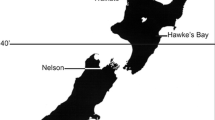Summary
Using a tuber-baiting technique,Phoma foveata and occasionallyP. solanicola were recovered from N. Ireland soils where potatoes had been grown in the previous year and from some where a potato crop had not been grown for over 5 years.P. foveata was consistently isolated from a proportion of stems produced by gangrene-affected tubers, grown in sterilized soil, from 3 weeks after planting to maturity; no symptoms of infection were visible until stems began to show signs of senescence when pycnidia formed on their surfaces. The incidence of infection was high in both stems and tubers from plants grown in soil heavily contaminated by inoculation withP. foveata or produced by gangrene-affected parent tubers, the lowest incidence being in stems and tubers from ‘healthy’ seed grown in soil neither sterilized nor inoculated. The close relationship between the incidence of stem infection on plants grown in variously treated soils, contained in sunken polythene bags in the field, and tuber infection in storage provides a possible method of predicting potential storage losses.
Zusammenfassung
Es wird eine Methode beschrieben (Isolierung des Erregers von der Knolle), die zur Untersuchung von Böden aus verschiedenen Regionen Nordirlands auf das Vorkommen vonPhoma spp. angewendet wurde. Die Ergebnisse (Tabelle 1) zeigen, dassP. foveata stets undP. solanicola gelegentlich in Böden, auf denen im vorhergehenden Jahr Kartoffeln angebaut wurden, nachgewiesen werden konnten, ebenso in einigen Böden, auf denen seit mehr als 5 Jahren keine Kartoffeln gepflanzt wurden.
In der Zeit von 3 Wochen nach dem Auspflanzen in sterilen Boden bis zur Reife konntenP. foveata immer undP. solanicola gelegentlich vom unteren Teil einiger ausPhoma-befallenen Knollen entstandener Stengel isoliert werden. Diese Stengel zeigten keine sichtbaren Befallssymptome bis zum Zeitpunkt, wo sie zu altern begannen und sich ihre Oberfläche mit Pyknidien bedeckte, was darauf hinweist, dassP. foveata undP. solanicola während der Vegetationszeit eine latente Stengelinfektion verursachen können.
Stengelzählungen (Tabelle 2) ergaben, dassPhoma-befallene Knollen mehr Stengel bildeten als ‘gesunde’ Knollen. Das Vorkommen sowohl der Stengelinfektion (Tabelle 3) als auch der Knolleninfektion am Lager (Tabelle 4) war extrem hoch, wenn entweder ‘gesundes’ oder krankes Saatgut in künstlich mitP. foveata stark verseuchte Böden ausgepflanzt wurde. Stengel- und besonders Knolleninfektionen waren auch bei allen Bodenbehandlungen zahlreich, wenn die Mutterknolle vonPhoma-Pilzen befallen war. Am wenigsten Stengel- und Knolleninfektionen traten auf, wenn gesundes Saatgut in nicht sterilisierten und nicht inokulierten Boden gepflanzt wurde. Die enge lineare Beziehung (R2 = 0,72, P>0,01) zwischen Stengelinfektion und nachfolgendem Vorkommen der Knolleninfektion am Lager erlaubt möglicherweise, die Menge der Knollen, die am LagerPhoma-fäule aufweisen wird, vorherzusagen.
Résumé
Les auteurs décrivent une technique par infection des tubercules pour tester les sols de différentes régions de l'Irlande du Nord pour la présence dePhoma spp. Les résultats (Tableau 1) révèlent queP. foveata est régulièrement présent, etP. solanicola occasionnellement, dans les sols qui ont porté une récolte de pommes de terre l'année précédente et dans quelques sols où la pomme de terre n'a pas été cultivée depuis plus de 5 ans.
P. foveata est régulièrement isolé, etP. solanicola occasionnellement, à la base quelques-unes des tiges provenant de tubercules atteints de gangrène, plantés en sol stérilisé, depuis 3 semaines après la plantation jusqu'à la maturité. Aucun symptôme visible n'apparait sur ces tiges jusqu' au début de la sénescence; à ce moment leur surface se couvre de pycnides, ce qui révèle queP. foveata etP. solanicola peuvent causer un type latent d'infection des tiges pendant la saison de croissance.
Le dénombrement des tiges (Tableau 2) montre que les tubercules atteints de gangrène produisent plus de tiges que les tubercules sains. L'incidence de l'infection à la fois des tiges (Tableau 3) et des tubercules pendant le stockage (Tableau 4) est très élevée quand des plants sains ou malades sont mis à pousser dans des sols gravement contaminés par inoculation avecP. foveata. L'incidence de l'infection des tiges et particulièrement des tubercules, est également élevée avec tous traitements de sol quand le tubercule-mère est atteint de gangrène. L'incidence de l'infection à la fois des tiges et des tubercules est plus basse à partir de plants sains récoltés dans des sols qui ne sont ni stérilisés ni inoculés. L'étroite relation linéaire (R 2 = 0,72,P>0,01) entre l'infection des tiges et l'incidence subséquente de l'infection des tubercules pendant la conservation laisse espérer une méthode possible de prévoir les chances de développement de la gangrène sur les tubercules pendant le stockage.
Similar content being viewed by others
References
Boyd, A. E. W., 1960. Fungicidal dipping and other treatments of seed potatoes in Scotland.Eur. Potato J. 3: 137–154.
Foister, C. E., Wilson, A. R. and Boyd, A. E. W., 1945. Potato dry rot and gangrene as soil-borne diseases.Nature, Lond. 155: 793–794.
Graham, D. C., 1964. The use of organo-tin compounds as potato tuber disinfectants, particularly againstRhizoctonia solani.Eur. Potato J. 7: 33–43.
Khan, A. A., 1967. A study of potato gangrene in Northern Ireland. Ph. D. Thesis, The Queen's University of Belfast.
Logan, C., 1967a. Potato stem infection byPhoma solanicola Prill. et Delacr. f.foveata (Foister) Malcolmson.Pl. Path. 16: 64–67.
Logan, C., 1967b. The control of potato gangrene by tuber disinfection.Res. Exp. Rec. Min. Agric., N.I. 16 (Part 1): 25–28.
Logan, C. and Coaker, T. H., 1957. The use of polythene for growing cotton plants under greenhouse conditions.Emp. Cott. Gr. Rev. 34: 189–190.
Malcolmson, J. F., 1958. Some factors affecting the occurrence and development in potatoes of gangrene caused byPhoma solanicola Prill. et Delacr.Ann. appl. Biol. 46: 639–650.
Todd, J. M., 1963. The development and control of potato dry rot, gangrene and skin spot.Seed Potato 3: 14–18.
Author information
Authors and Affiliations
Rights and permissions
About this article
Cite this article
Khan, A.A., Logan, C. A preliminary study of the sources of potato gangrene infection. Europ. Potato J. 11, 77–87 (1968). https://doi.org/10.1007/BF02364460
Accepted:
Issue Date:
DOI: https://doi.org/10.1007/BF02364460




